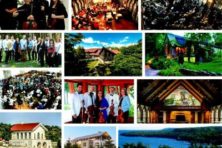CULTURE CLUB: Who Is the Conductor in Chamber Music?
- Share
- Tweet
- Pin
- Share
by Allyson Fleck, Executive Director, Midsummer’s Music
“How do you perform chamber music without a conductor?” That’s a question I hear often as a violist with Midsummer’s Music.
I have performed with the ensemble since 2005, but I also have extensive experience playing in numerous stage, touring, pop, pit and regional orchestras. I have even had the good fortune of performing with nationally acclaimed ensembles.
In 2004, I received a doctorate in music arts from UW-Madison in viola performance, with a minor in orchestral conducting. Learning how to conduct instilled in me a great admiration for the leadership role in a musical setting – a role that later led me to arts management and my current position as Midsummer’s Music’s executive director.
An orchestra conductor can lead upwards of 100 musicians; however, in a chamber music ensemble, there are typically three to nine players. The conductor of an orchestra is often visible to the audience, but what about in chamber music? You never see a conductor standing in front of a small ensemble, yet somehow, the musicians have to find a way to play together.
At Midsummer’s Music, our musicians have all lived, shared, loved, taught and experienced the joy of making music. We perform as a team and feel like a family.
Preparations for our rehearsals are done individually, as each musician marks scores and listens intently to recordings of great performances before gathering for the first time. Chamber musicians know to check any egos at the door because everyone’s voice is respected with equal importance.
During a recent rehearsal for Mozart’s “Kegelstatt” Trio, our musicians briefly discussed and agreed on a rehearsal strategy before getting to work.
In chamber music, musicians have the advantage of intimate connections in which – most importantly – they listen. With no conductor, they must express thoughts silently to each other. Occasionally during rehearsals, however, there is some verbal communication. (I’ve groaned “Ugh!” out loud when missing a pitch or an entrance.)
When they get to the end of a movement, the musicians often talk about tempo, phrasing, articulation and dynamics. Any new concept that is proposed to the group’s members is immediately tried, and if it works well, they mark their parts and proceed. Otherwise, they discuss alternative ideas. Sometimes they agree that a rehearsal spot is just fine.
The Midsummer’s Music ensemble often leans on first violinist David Perry, who always knows what to suggest to the group. In all, the playing-to-discussion ratio needs to be around 9:1, meaning we do not need to speak much – mainly play.
During concerts, the audience can see how musicians express thoughts to each other with their eyes and physical movements such as head nods, leaning forward and breathing. Midsummer’s Music performs each program several times, and by the second performance, musicians can experiment with phrasing, tempo and gestures. It’s all unrehearsed and unspoken, and it’s possible only through deep trust and curiosity.
Compare this type of rehearsal and performance – where musicians are listening to each other – to that of an orchestra, where the leadership is maintained by one voice: the conductor. Ultimately, that leader makes the decisions. So much can happen by listening in a chamber ensemble. In an orchestra, it can be challenging to hear the back of a violin section if you’re the timpanist, so the conductor is the bridge and manager.
During a Midsummer’s Music string-quartet outreach event, musicians asked the Boys and Girls Club kids to experiment with chamber music. How could they get the quartet musicians to play faster or louder without using words? What a challenge.
They exceeded expectations and had a great time. One student made amazing eye contact and inched forward to the first violinist. They were making music together. The experience was amazing. The musicians asked the students how they can take that nonverbal communication back to their classroom, and they were truly inspired. Actions speak louder than words.
I hope you will join us for upcoming Midsummer’s Music concerts where you, too, can experience what it’s like to be in the ensemble. It’s also incredible how chamber musicians respond to the audience. When you sigh, laugh and applaud, we are part of that experience. We are listening to you, too.
The next concerts feature piano trios by Laura Netzel, Joachim Turina and Franz Schubert on July 15, 7 pm, at St. Luke’s Episcopal Church in Sister Bay; July 16, 7 pm, at Hope United Church of Christ in Sturgeon Bay; July 17, 3 pm, at the Trenchard residence as a salon concert; and July 21, 7 pm, at the Kress Pavilion in Egg Harbor. Visit midsummersmusic.com for further details.
Peninsula Arts and Humanities Alliance, which contributes Culture Club throughout the summer season, is a coalition of nonprofit organizations whose purpose is to enhance, promote and advocate the arts, humanities and natural sciences in Door County.



